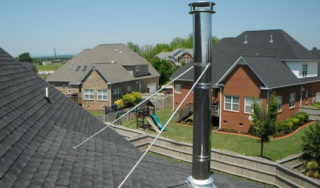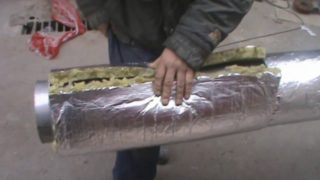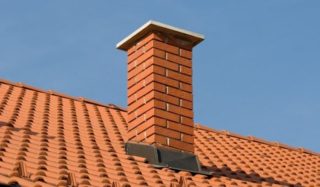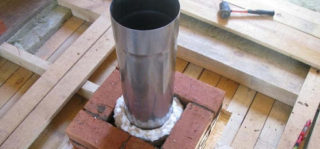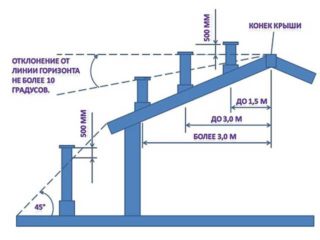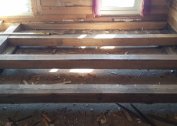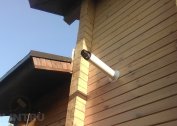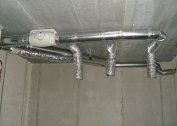In private houses and cottages in heating systems, boilers and stoves that operate on a particular type of fuel are used. In the process of combustion, smoke, carbon monoxide is formed. It should be diverted outside the premises. This function is performed by the chimney. The height of the chimney pipe above the roof plays a big role, because if the standards are not followed, the system becomes ineffective, fuel consumption increases, smoke is drawn back into the room, and fire safety is reduced.
The main criteria and requirements for the design of the chimney
The gas generated by the combustion of fuel significantly affects the temperature in the house. By correctly designing the chimney, you can more efficiently use the thermal energy of the flue gases. In addition, the design features of the chimney significantly affect the efficiency of heating appliances and fuel consumption.
Effective operation of the chimney and compliance with fire safety standards are ensured even during the preparation of the draft scheme. The following criteria are taken into account:
- Material. Must withstand the temperature of the exhaust gases in each case. The residual temperature is determined by the type of fuel.
- The parameters of the cross section of the chimney channel and its height must comply with the technical requirements. If you do not make the necessary calculations, the operation of the heating unit will be incorrect.
- The ventilation ducts for heating appliances, a fireplace, a stove are combined, because the construction of individual channels is impractical. In this case, additional calculations and measurements are necessary.
The height of the chimney is determined by:
- location relative to the ridge;
- a rose of winds;
- the angle of the roof;
- average annual snow height;
- wind speed;
- the presence of obstacles that block the free movement of air: trees, buildings.
In addition, additional recommendations should be observed:
- The chimney height from the lower point to the outlet is at least 5 m.
- If tall houses and a boiler are built nearby, the stove is heated by wood, the pipe rises at least to the roof level of neighboring buildings.
- The height of the ventilation ducts, which are located close to the chimney, should be equal to the height of the chimney.
- It is not necessary to bring the chimney channel to the joints of the roof slopes - the valley, in the winter snow will accumulate here.
According to the regulations, it is not recommended to rigidly connect the design of the chimney with the rafter system and the roof in order to avoid damage when exposed to the pipe.
The nuances of choosing a chimney
It is necessary to calculate the height of the chimney and determine the size of its cross section at a certain position of the pipe. When the height increases and the cross section decreases, the thrust increases, and vice versa: when the height decreases and the cross section decreases, the thrust decreases. It is necessary to select such a ratio that the thrust was optimal - the efficiency did not decrease and carbon monoxide was removed.
Cylindrical channels are better suited for sectional shape. They warm evenly, therefore, to the greatest extent contribute to the uniform movement of fuel gases. If the chimney is rectangular, it warms up and expands unevenly, because of this it gradually collapses.
Unequal heating of different parts of the surface negatively affects the process of natural traction. For a chimney that removes combustion products from a stove or fireplace, this is acceptable.The upward flow moves in a spiral, turbulence occurs, which contributes to a more complete use of thermal energy. However, more soot and burning is formed. Choosing a chimney for a boiler that runs on gas or solid fuel, it is definitely worth choosing a cylindrical one.
The material of the manufacture of the chimney matters. A brick mine is optimally suited to the use of solid fuels, such as firewood. But this is not the best option when heating with a gas boiler.
Types and characteristics of chimneys
Chimneys made of different materials will differ in their characteristics.
Asbestos-cement pipes are traditionally used to equip chimneys and are still considered the most budget option, but far from the best. Chimneys made entirely of asbestos are unsafe to operate:
- when heated, carcinogens are released;
- material cracks and breaks at temperatures above 300 ° C.
It is permissible to make only sections remote from the heat source from asbestos-cement pipes. But when assembling, it is difficult to achieve tightness, including when using other materials. Asbestos has a porous and rough structure, so the surface quickly grows with soot and absorbs condensate, which destroys the pipe and reduces traction.
Brick chimneys are a classic. Strengths balance out weaknesses. Of the benefits noted:
- impressive service life - more than 50 years;
- fire resistance;
- aesthetic appearance.
Disadvantages:
- complex assembly and maintenance;
- rough surface accumulating soot;
- significant weight of the structure;
- susceptibility to acidic environment.
Solid metal chimneys are made of stainless steel. When installing them, there are no significant difficulties. They are characterized by numerous advantages:
- light weight;
- anticorrosive properties;
- resistance to high temperatures (up to 500–700 ° C);
- smooth inner channel;
- long service life (15 years or more);
- prevent condensation.
There are also disadvantages: limited use due to thin walls. They can be used only as a sleeve of a brick shaft or indoors. In order to expand the scope of use, all-metal chimneys are insulated.
The modular chimney is devoid of almost all the shortcomings characteristic of other types of chimneys and is versatile. It is a double-circuit sandwich pipe with a layer of mineral wool 2-6 cm thick. Its installation is as simple as possible, due to the possibility of assembling the channel from a variety of shaped elements.
General Provisions
The location of the highest point of the chimney is of great importance for fire safety and the efficiency of the heating system. Natural cravings are formed according to the laws of physics: warm air tends to rise, and a new portion takes up the vacated space, since the vacuum instantly fills. The more heated air, the more intense the draft, which is interconnected with the height of the chimney and its cross section. The purpose of all calculations and recommendations is to achieve such an upward flow rate so that heat losses are minimal, but at the same time the combustion products do not have time to get into the room. Too much traction is not desirable, because heat will not be transferred to the air masses, and to maintain a comfortable temperature in the house will have to burn more fuel.
Another aspect needs to be taken into account: an excessively high pipe will adversely affect the exhaust system of the fuel combustion products, although it would be logical to assume that the higher the chimney, the greater the draft.This is true, but the stream, rising higher, gradually cools, and the cold air tends to down. At a certain moment, an air congestion is formed from cold gas, which presses downward on the rising warm stream and prevents it from rising higher - the thrust comes to naught. In addition, the situation is aggravated by the fact that condensation occurs when the gas cools. It further reduces traction.
It is advisable to position the chimney from the ridge at a distance of not less than 50 cm and not more than 150 cm. The height of the chimney above the ridge is not less than 50 cm. This placement is successful for practical reasons:
- at this level, snow accumulates in less quantity, therefore, the risk of leaks at the junctions is reduced;
- materials are saved during construction.
You can bring the pipe out into the street, removing it 1.5-3 m from the ridge, then the height of the chimney should be: maximum - level with it, minimum - with a deviation of no more than 10 degrees from the horizon, if you draw an imaginary straight line through the highest points of the chimney and skate. The last criterion is valid for the highest point of the pipe, if it is located at a distance of more than 3 m from the ridge. The height of the chimney pipe above the roof should be at least 50 cm. It is not necessary to remove the chimney channel at the level of dormers to avoid drawing carbon monoxide into the room.
Standards regarding the location of the chimney relative to the roof ridge are set out in SNiP41-01-2003 and SP 7.13130.2009.
Determining the location of the chimney relative to the ridge and its height is a necessary stage in the design of the heating system. But in addition to this aspect, it is necessary to take into account a host of other conditions and initial data: fuel type, boiler capacity, material properties, the presence of additional channels that exhaust combustion products from the fireplace, stove, climatic parameters, and the preferred wind direction. Having familiarized with the requirements of SNiP on the height of the chimney, you need to make additional calculations. For example, calculate the cross section of the chimney. Calculations for complex projects with a large number of objects must be performed by professionals. Using a chimney designed with errors can be life threatening.

